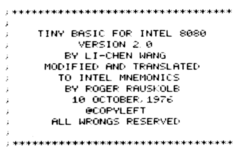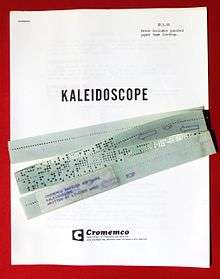Li-Chen Wang

Dr. Li-Chen Wang (born 1935) is an American computer engineer, best known for his Palo Alto Tiny BASIC for Intel 8080-based microcomputers. He was a member of the Homebrew Computer Club and made significant contributions to the software for early microcomputer systems from Tandy Corporation and Cromemco.[1]
Palo Alto Tiny BASIC
Palo Alto Tiny BASIC was the fourth version of Tiny BASIC that appeared in Dr. Dobb's Journal of Computer Calisthenics & Orthodontia, but probably the most influential. It appeared in the May 1976 Vol 1, No. 5 issue,[2] and distinguished itself from other versions of Tiny BASIC through a novel means of abbreviating commands to save memory, and the inclusion of an array variable ("@"). The interpreter occupied 1.77 kilobytes of memory and assumed the use of a Teletype Machine (TTY) for user input/output. An erratum to the original article appeared in the June/July issue of Dr. Dobb's (Vol. 1, No 6.) This article also included information on adding additional I/O devices, using code for the VDM video display by Processor Technology as an example.
Dr. Wang also wrote a STARTREK program in his Tiny BASIC that appeared in the July, 1976 issue of the People's Computer Company newsletter.
Tandy Corporation
The original prototype TRS-80 Model I that was demonstrated for Charles Tandy to sell the idea ran Li-Chen's BASIC.[3]

Dr. Wang's mark also shows up in and on the Exatron Stringy Floppy ROM for the TRS-80 Model I. According to Embedded Systems columnist Jack W. Crenshaw, Li-Chen's Manchester encoding code, achieving 14K read/write speeds, is a "work of art." [4]
Cromemco

The first color graphics interface for microcomputers, developed by Cromemco and called the Dazzler, was introduced in 1976 with a demonstration program called "Kaleidoscope" written by Dr. Wang. According to BYTE Magazine the program, written in 8080 assembly code, was only 127 bytes long.[5] But this short program stopped traffic on 5th Avenue in New York City.
Stan Veit was the owner of The Computer Mart in New York City. He placed a color television in his store window displaying the colorful, ever-changing kaleidoscopic patterns generated by the Dazzler and Wang's software. According to Veit: “People driving by began to stop and look – they had never seen anything like it before. In a short time the Dazzler had caused a traffic jam on 5th Avenue!” The police had to contact the building landlord and make him disconnect the television.[6]
Dr. Wang also developed "3K Control Basic" for Cromemco.[7]
Other contributions
Dr. Wang also created WSFN ("Which Stands for Nothing"), a programming language for controlling robots and published by Dr. Dobb's Journal in September 1977.[8]
In 2001 Dr. Wang was re-elected for a second term as chair of the Infrared Data Association's Technical and Test committee. In 2004 Dr. Wang was employed as Chief Technical Officer at ACTiSYS in Fremont, California, focused on IR/mobile products.
References
- ↑ Lash, Bob. "Memoir of a Homebrew Computer Club Member". Retrieved May 6, 2013.
- ↑ Wang, Li-Chen (May 1976). "Palo Alto Tiny BASIC". Dr. Dobb's Journal of Computer Calisthenics & Orthodontia, Running Light Without Overbyte. 1 (5): 12–25. Source code begins with the following six lines. TINY BASIC FOR INTEL 8080; VERSION 1.0; BY LI-CHEN WANG; 10 JUNE, 1976; @COPYLEFT; ALL WRONGS RESERVED
- ↑ Welsh, David and Welsh, Theresa Priming the Pump: How TRS-80 Enthusiasts Helped Spark the PC Revolution p. 7, Copyright © 2007
- ↑ Crenshaw, Jack W. "More on Interpreters". Programmers Toolbox Column. Retrieved 5 April 2011.
- ↑ Helmers, Carl (June 1976). "About the Cover". BYTE (10): 6–7. Retrieved February 18, 2013.
- ↑ Veit, Stan (March 1990). "Cromemco - Innovation and Reliability". Computer Shopper. 3. 10 (122): 481–487.
- ↑ "3K Control Basic Instruction Manual" (PDF). Cromemco. Retrieved 2013-02-18.
- ↑ Wang, Li-Chen, "An Interactive Programming Language for Control of Robots", Dr. Dobb's Journal, 2 (10)